How to clean windows streak-free at home?

Clean windows mean a well-kept and bright house. Do you want to know how to clean windows to perfect cleanliness without spending too much time and effort on it? We will tell you how to solve this problem at home. For each task, we will describe the necessary materials, detergents and give some important tips to remember.
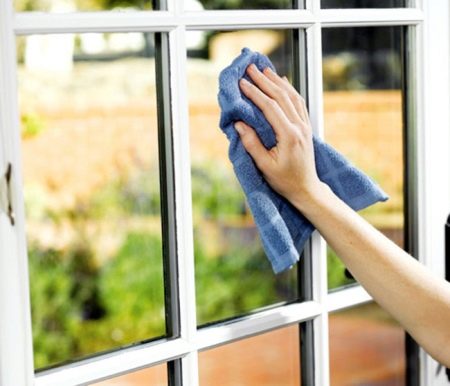
Necessary materials
If you are not using special cleaning wipes, then you will need to wash:
- a sponge or rag made of coarse linen (you can choose microfiber or nylon);
- a bucket or bowl in which there will be a cleaning solution;
- the cleaning agent itself or solution;
- cleaning absorbent cloth;
- you can also use a special scraper with a silicone attachment to remove excess moisture.
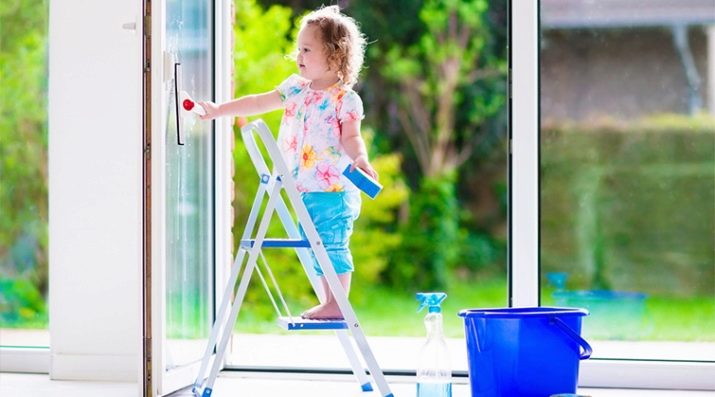
A wide variety of tools can be used to clean windows. Folk remedies are the most economical option, since you can find everything you need in your kitchen.
They are not always effective against stubborn dirt and difficult stains (primer, cement, soot, glue, etc.), but they do an excellent job with dust and dirt, as well as various kinds of stains (from insects, rain, etc.).
Most popular remedies
Popular among housewives are:
- Liquid ammonia will wash plastic windows without leaving streaks. It will also perfectly remove nicotine film from frames. Take 100 ml of ammonia (you can use flavored alcohol) and dissolve in a bucket of cold water. Unpleasant odors are indispensable in the apartment, therefore, after washing the windows, the room must be thoroughly ventilated.
- Windows can be perfectly cleaned using regular 9% vinegar. Use 4 tbsp. l. vinegar and 2 liters of cold water. With vinegar, you will not only clean windows to a shine. Due to its pungent odor, it perfectly protects the house from insects entering from the street.
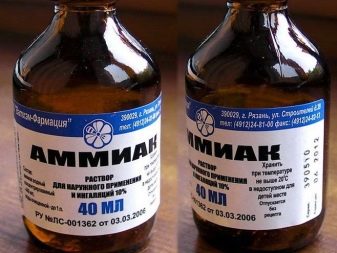
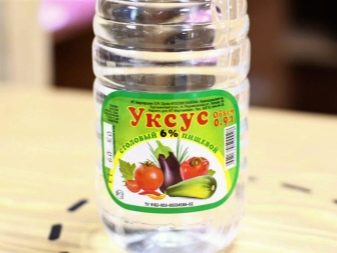
- Starch can also be used to clean stained windows. Prepare the following solution: 2 tbsp. l. Dissolve starch in 2 liters of water. Stir the starch well. With the resulting mixture, wash the window with a sponge or a piece of cloth.
- Potato. If there are a lot of dried stains on the window, wipe the window with half a potato, and then simply remove the remaining dirt with a dry microfiber cloth. Stains and dirt will be removed. Then wash with clean water or water with vinegar until shiny.
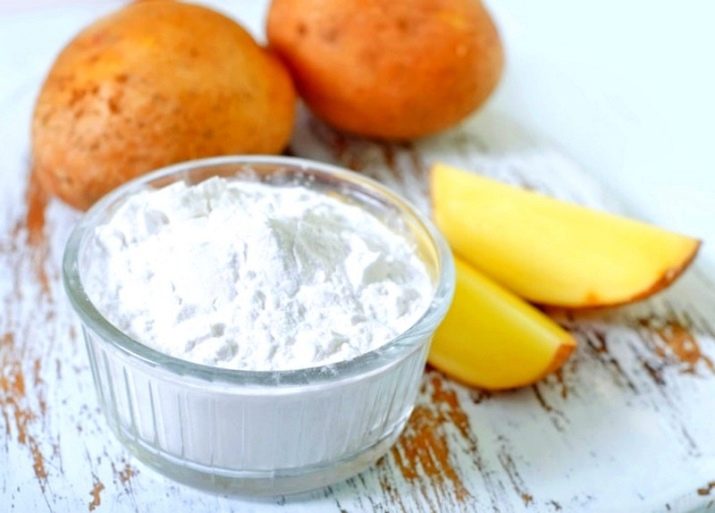
If you wipe the glass with potatoes, and then just walk with a regular rag, then the resulting starch film on the window will protect it from fogging. This method can also be used for machine glasses.
- Chalk powder. 3 tbsp. l. such a powder must be diluted in a glass of water or vodka. Rub the resulting thick paste over the surface of the window and leave to dry. Then we remove the chalk from the surface with a napkin or microfiber. The vodka in the resulting paste will perfectly degrease and wash the window without streaks.
- Onion. Fly stains can be removed from fiberglass with half an onion. Then it only remains to rinse the surface with water and wipe with a dry cloth.
- Cooking salt will allow you to clean the window from dirt no worse than special products. Dilute a few tablespoons of salt in a glass of water and wipe the window with a microfiber solution.
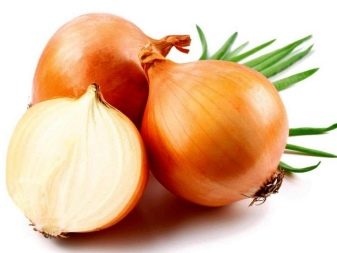

- Glycerol. You can clean the window and protect it from further contamination by using regular glycerin from the pharmacy, mixed with liquid soap. Glycerin can also be diluted with water (100 grams of glycerin and 50 grams of water) and ammonia (small amount). A film forms on the surface of the window, which protects the window from scratches and dirt.
- Kerosene. You can use kerosene to make your windows shine. A tablespoon of kerosene must be diluted in 3 liters of water.
- Nylon tights can be used to clean windows instead of special microfiber rags. Among other things, they will allow you to achieve the shine of the glass.
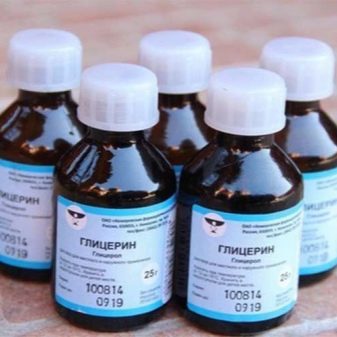
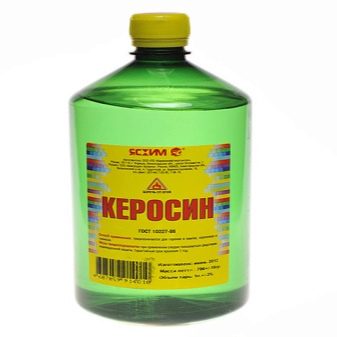
- The window can be washed with a solution of potassium permanganate and blue, which gives the glass a bluish tint. It is important not to overdo it with the powder so that the solution is light, translucent in color.
- Wipers. Modern supermarkets offer many special glass cleaners. They are available in the form of sprays that are distributed over the entire surface of the window using a dispenser, powder that must be dissolved in water, gels and pastes that are applied to the window with a rag or sponge.
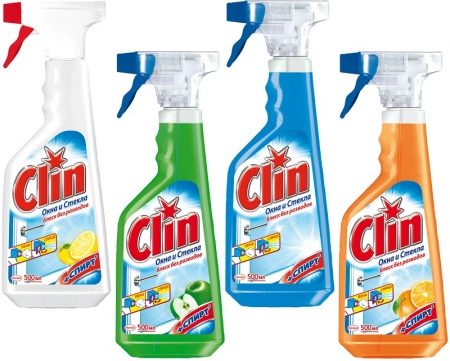
How to clean glass?
If you want to clean the glass quickly and effortlessly and to avoid smudges, use a few tips:
- First, wipe the window with a sponge to shake off any dust.
- Walk on the surface of the glass with a rag soaked in a special solution (you can use the folk remedies listed above, or special sprays, powders, gels, pastes, napkins for cleaning glass). If the apartment has large panoramic windows or you wash the balcony windows, you can use a special spray bottle.
It is better to clean window panes on the balcony with a double-sided mop with a sponge and a scraper. First wipe the window with a sponge and then remove any remaining water with a silicone-tipped scraper.
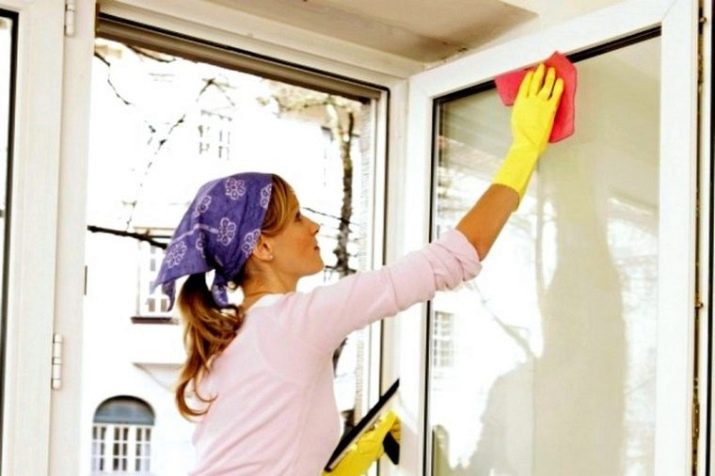
- Further, the agent is removed from the glass surface with a special rubber scraper. Choose wide scrapers for large windows. Move from top to bottom, turning the scraper slightly to the side.
- Then the glass needs to be polished. This last step is especially important if you want the windows to be washed streak-free and shiny. Wipe the glass dry with a crumpled newspaper (you can also use a piece of suede, nylon stockings or tights, a special napkin).

Now let's talk about strong remedies that will allow you to get rid of dried spots and dirt at home:
- Pour 4 liters of warm water into a bucket and add 100 ml of ammonia and white vinegar, add a small amount of blue and 2 tbsp. l. starch. The resulting solution must be applied to the window with a rag or spray bottle, then wipe the window with a napkin or sponge. A solution with ammonia also perfectly cleans glass from glue.
- You can remove black insect spots from the surface by wiping the dirty areas with half of the onion. This method will help to clean the window from stains effortlessly.
- If you need to clean the window after a fire and remove the soot, first remove the soot residues with a broom or dry cloth. After that, wash the window with water and a cleaning agent (both a special glass cleaner spray and a bathroom cleaner will do). Plastic windows can be cleaned from soot with chemical alcohol, thinner, gasoline and other alcohol-containing products.
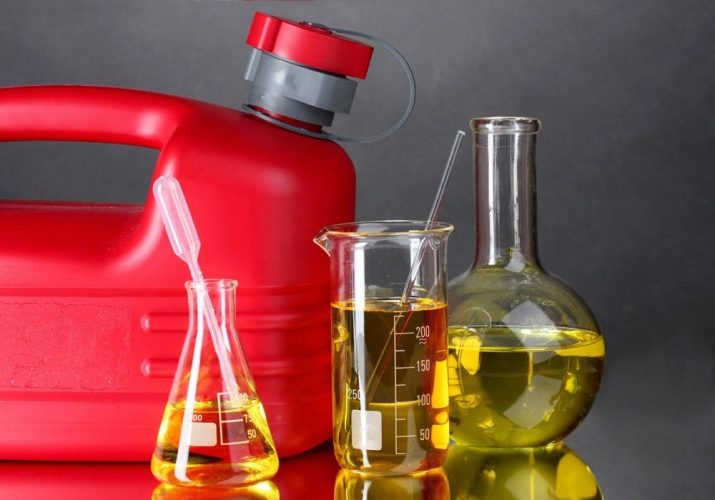
- After installation, you can clean plastic glass from foil or glue using a solvent or ammonia. You can also use dish soap. It needs to be applied to a sponge and lather well. Then apply the resulting foam to the window surface and wait 10 minutes. Then rinse with plain water and wash the window with a regular detergent to get rid of streaks.
- If you want the windows to shine, then a solution of 2 tbsp is perfect for this. l. vinegar diluted in a bucket of water. Windows will be cleaned without streaks and with the desired shine.
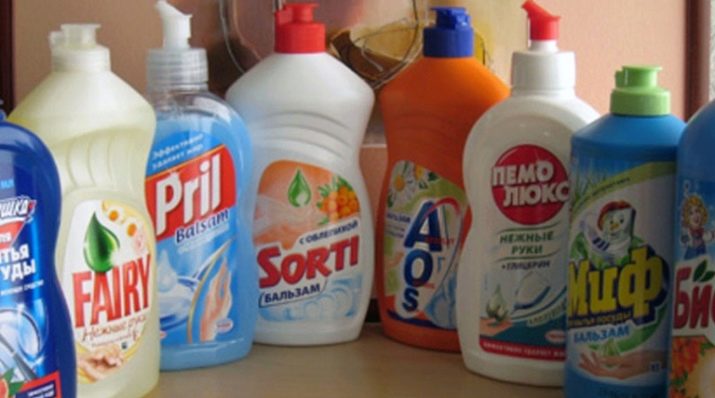
Take a note: in order to properly wipe away stains on the glass, without damaging the surface or leaving streaks, it is better to wash the windows in a circular motion from top to bottom.
Wash the glass only in dry weather and not in the sun, as this will quickly dry out the cleaning agent on the window surface, leaving strong streaks.
How to clean the windowsill and frame?
If your house has wooden frames and a window sill, then it is better to wash them with liquid soap or dishwashing detergent diluted in a bucket of water. Harsh abrasives can damage paints and are not desirable for cleaning such windows. Soda is also not recommended for cleaning wooden window sills and frames. Do not forget to oil the metal fittings after washing the frame.

Plastic frames and windowsill. To clean the frame and sill, you can use:
- an ordinary sponge or rag;
- a toothbrush to remove dirt from crevices;
- hard brushes are great for rough window sills;
- melamine sponge for heavily soiled plastic surfaces. The melamine sponge releases foam on contact with water. No additional cleaning agents are required. However, melamine is toxic and should be used with caution and only on surfaces that do not come into contact with food.
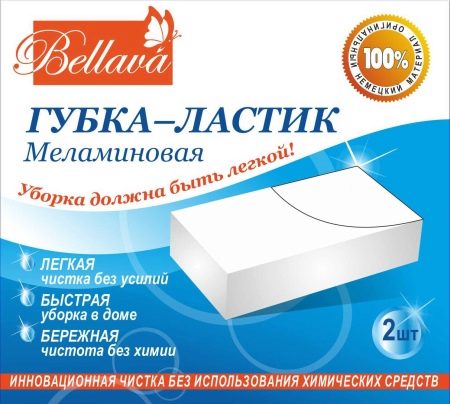
It is best not to use a metal scraper to avoid scratching the surface. For light dirt on plastic, it is better to use liquid or laundry soap. Dissolve the soap in a bucket of water and wash the frame with a regular cloth. As an alternative to soap, you can use another alcohol-based cleaner. It is better to do without solvents and alkalis.
If you are faced with the task of not only washing the window sill and frame, but also removing more difficult stains from the surface, then special tools will help you here.
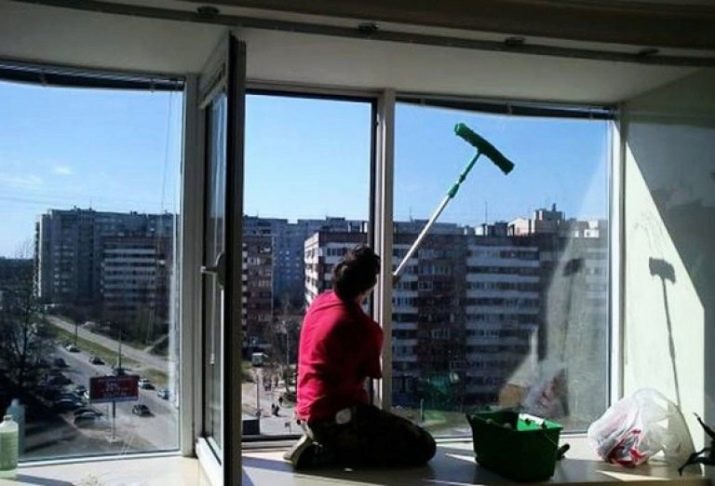
Plastic frames and window sills turn yellow over time. You can achieve the whiteness of plastic in the following ways:
- Soda. To get rid of yellowness and stubborn stains on the windowsill, baking soda is perfect. To prepare the solution, use a small amount of baking soda diluted in water. The solution must be soft so as not to damage the plastic surface. If there are old stains on the surface of the plastic, you can use baking soda and 9 percent vinegar.First, sprinkle baking soda on contaminated areas, and then walk on the surface with a sponge soaked in vinegar. The stains will be removed and the white surface is effectively cleaned. Then we wash the frames and the window sill with a regular cloth and cold water.
Vinegar is corrosive to the skin and has a strong odor, so clean with gloves and ventilate the area after cleaning.
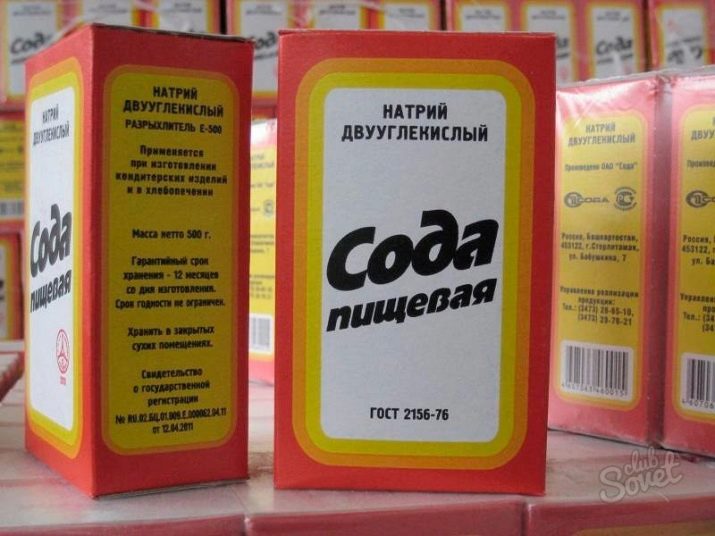
- Powder for white clothes perfectly whitens plastic. The powder must be diluted in a small amount of hot water (to get a thick mixture). The resulting paste must be applied to the surface, if necessary, leave to act for 10-15 minutes, then wipe with a hard sponge and rinse with plenty of warm water. After that, wipe the plastic surface dry with a paper napkin or towel. Instead of powder for white laundry, you can use powdered white chalk, remnants, or tooth powder. The algorithm of actions will be the same.
Chalk and tooth powder are more gentle abrasives, so they deal with stains more delicately.

- Special means. Numerous special cleaning products from the store will help you quickly and easily wash plastic from stubborn stains and rust. Powdery and aggressive detergents must be used with care so as not to damage the plastic surface. Laminated plastic can be washed with any product without fear. A cleaning spray usually needs to be applied and left on the surface for a few minutes. 15 minutes after applying the product, it will not be difficult to remove stains. The product must be thoroughly washed off the surface. If necessary, the room can be ventilated.
- Also, to remove greasy stains from the windowsill, you can use degreasing products for the kitchen. Domestos for the bathroom will help to remove significant dirt, rust and difficult stains. Apply the product to the surface, leave it to act for 20 minutes, and then rinse thoroughly with water.

When using aggressive, toxic products (these include most powerful stain removers), clean only with rubber gloves and a respirator to protect your hands and respiratory tract. Ventilate the room at the end of the work. After the window has dried, a little machine oil should be applied to the metal fittings, the rubber seal should be treated with silicone grease.
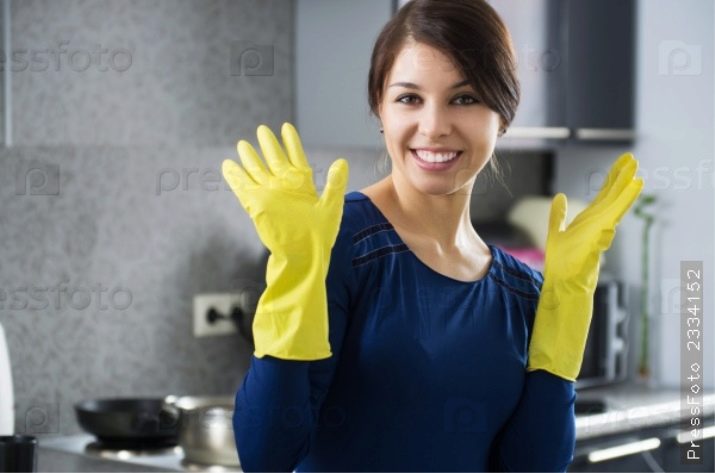
Use caution with cleaning powders (acceptable for laminated plastics) and detergents containing gasoline, thinner or acid. All of these products destroy the surface of the plastic.
It can be quite difficult to clean the gap under the frame, in which, as a rule, a lot of dirt and dust accumulates. You can use an old toothbrush to clean the crevice. She will not only thoroughly wash the gap, penetrating into hard-to-reach places, but also has a sufficiently soft bristle so as not to damage the plastic.

How to clean after repair?
Dried stains from paint, primer, concrete contact, cement are not always removed with an ordinary damp cloth. Therefore, cleaning the windowsill and frame often requires strong detergents. So that cleaning does not take too long, you must act in the correct order:
- Before starting cleaning, it is better to remove all the plugs in order to wash out the cracks in which a large amount of dirt accumulates after repairs.
- Then brush off all dust from the windowsill, frames and panels with a brush or a piece of dry cloth.
- Remove stains with a stiff brush, not a rag. Stains from paint, glue or cement are removed using products containing abrasive substances. They are applied for 15-20 minutes, and then removed from the surface with plenty of water, you can add laundry soap.

To wash the primer, you must first soak it. Alcohol or polyurethane foam is suitable for this.On the stain from the primer, you can apply its own solution and quickly wipe it with a dry cloth. Then wash the surface with a damp cloth.
The primer can be soaked with wet rags. They should be placed on top of the primer stains for a few minutes. And then remove with special products and a sponge, it does not require much effort. Better to use an abrasive sponge. It will not damage the plastic.
Instead of a sponge, you can use a special scraper, positioning it at a slight angle to the surface. If there is still dirt in the spot, it can be removed with a powder solution.

Likewise, you can try scrubbing dry cement stains. Then wash off the remaining dirt with special products.
If you need to clean cement stains, it is best to wait until they dry before starting to clean the windowsill. The cement can be carefully scraped off first with a special scraper. You need to act carefully so as not to damage the plastic surface. Then wash off the remnants with a special agent for cleaning surfaces from cement, primer, glue and other building materials. These tools include Dopomat, Hodrupa A, Szop (also cleans up rust).
Stubborn dirt from a plastic window sill can also be removed using a solvent (acetone, turpentine, ethyl acetate, alcohol). But they must be resorted to as a last resort, since there is a risk of damaging the plastic surface.
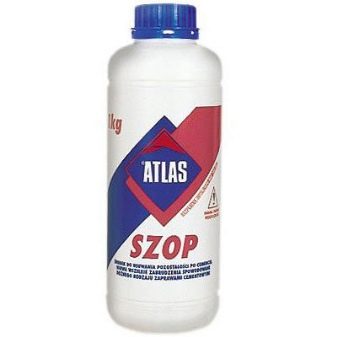
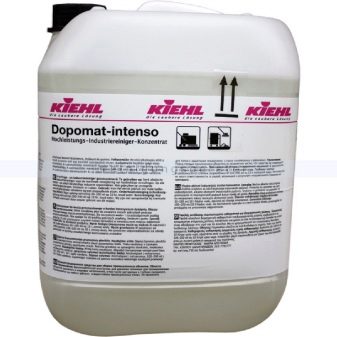
"Mister Muscle" - a fairly effective tool that you just need to apply to the glass surface and wipe with a sponge. Then rinse the glass clean with clean water. The product will wash dirty windowsills and frames to a shine.
Table Vinegar - Use a high concentration vinegar solution. It can be used to remove difficult stains from the primer, but it is imperative to work with a respirator or mask. Upon completion of cleaning, wipe the surface with a dry cloth or paper towel.
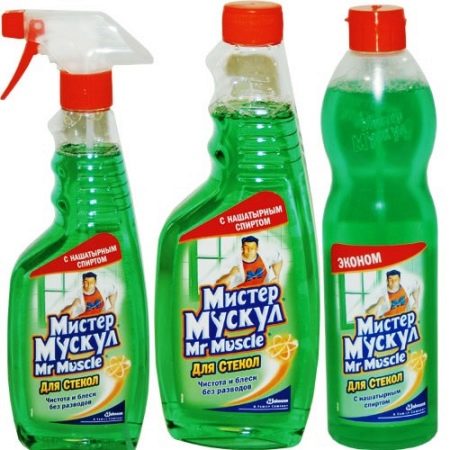
A special cement remover will help to clean the concrete contact. However, it is best to scrape off the cement first with a scraper while the stain is dry. Only then remove the remaining stains with a product.
My mosquito net
So that in the summer fresh clean air gets into the room, and not dust and dirt from the street, wash the mosquito net in time. A darkened mosquito net is a signal for action.
All you need to clean the mesh is ammonia (or other chlorine-based detergent), rubber gloves, a water hose, tarp or thick film, a stiff brush, and a microfiber cloth, or other absorbent cloths. It is better to wash the mesh from a hose with a gentle pressure of water.

Procedure:
- First, remove the mosquito nets from the windows and prepare them for cleaning. Place the mosquito net on a protective film or any other waterproof material (such as a tarp) to avoid damage during washing.
- Prepare a solution with water and ammonia in a ratio of 3: 1. Stir the solution only with rubber gloves to protect the skin of your hands.
- Use a low-pressure water jet to remove dirt from the window mesh. Remember to turn it over and rinse the other side. This will wash away dirt and dust.
- Take a stiff brush and dip in the solution. Start cleaning the mesh from top to bottom. Try to rinse the brush in the solution as often as possible.
- Rinse the frame thoroughly with a jet of water.
- Next, rinse the mesh with clean water from a hose from top to bottom to rinse out any remaining dirt. Check for stains on the mesh. If necessary, rinse the mesh again with water from the hose.
- Shake off the water remaining on the net by lightly tapping the net on the ground.
- Wipe the clean mesh with a dry absorbent cloth and leave to dry in the fresh air.
The clean, dry mosquito net can now be replaced. It is better to wash it, after removing it from the window, so as not to stain yourself and the furniture around.
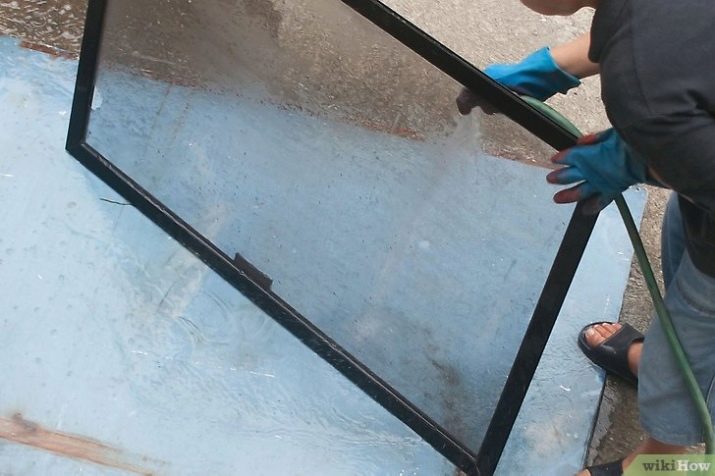
Do not mix ammonia and bleach to wash the mesh, the solution is toxic and very hazardous to health.In the summer, wipe the mesh with a damp cloth, or vacuum up dust and dirt at least once a week so that the seasonal cleaning of the screens does not take too much time and effort.

How to wash outside?
Cleaning windows outside is a rather difficult task. If it is not so difficult for those who live on the lower floors to do this, then for residents of apartments above, washing the balcony windows from the outside is a real problem. However, there are several ways to make the process easier.
To get started, prepare all the necessary materials:
- sponges (it is better to choose not too hard, so as not to damage the plastic or paint of wooden frames) and microfiber;
- two buckets (for detergent and for clean warm water);
- a mop with a brush (or a double-sided mop with a brush and a scraper);
- ladder;
- a squeegee with a rubber nozzle so as not to damage the window.

Do not use acid, alkali or other aggressive substances to clean windows. They destroy the protective film on the glass surface, which filters out direct UV rays. Alcohol-based products are more suitable. Also perfect for cleaning windows outside, a soapy solution or a solution of ammonia (1 tbsp. L. For 2 liters of warm water).
The safest way is to simply pull the glass out of the wooden frame or the plastic window from the grooves and calmly clean the windows at home. If this is not possible, and you live on a high floor, it is better to turn to the services of special cleaning companies.
If you nevertheless decide to wash the windows outside on your own, then try to ensure maximum safety. Get someone to back you up.
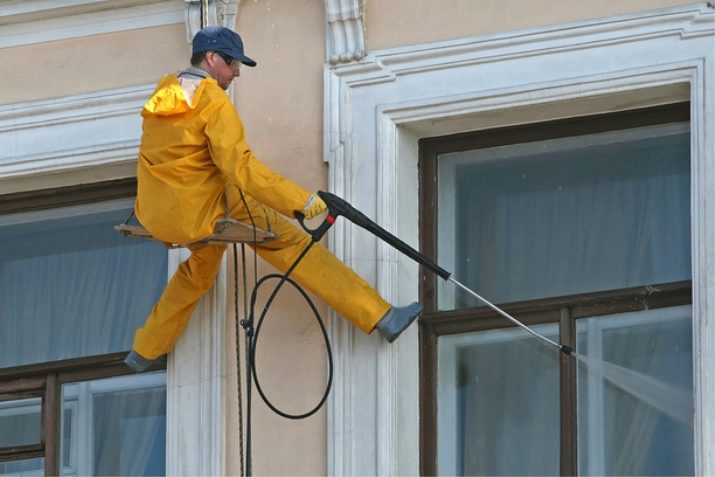
Operating procedure:
- Use a double-sided mop (sponge on one side, brush on the other) for cleaning. It is also best to use a mop with a variable handle.
- Clean the window with detergent using a sponge mop.
- Remove excess moisture with a silicone-tipped scraper (the other side of the squeegee).
- Wrap a clean, dry cloth around the mop and dry the window surface to a shine.
- Most often, windows are washed in the warm season, and in winter only from the inside.
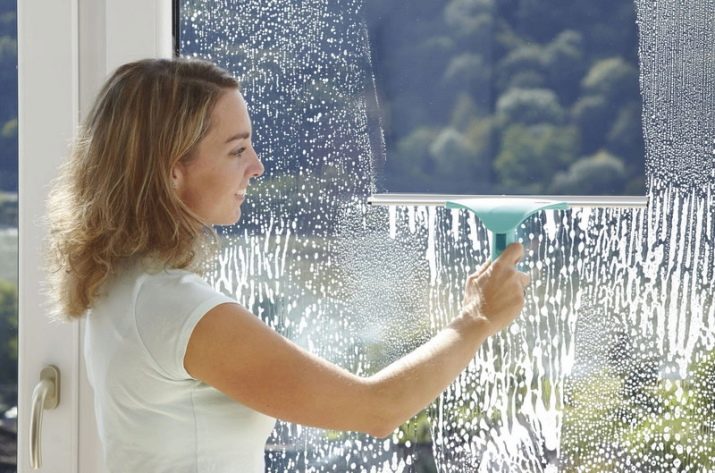
But if you need to wash the balcony window at freezing temperatures outside, remove the ice, then you can do this using a few tips:
- It is better to wash the balcony window first from the inside, and then from the outside. This will make external stains easier to spot and clean.
- Wash the frames first and then proceed with the glass itself.
- Dissolve in 1 liter of water 2 tbsp. l. salt. Apply the solution to an icy window using a mop. You will see the ice begin to melt.
- After making sure that the ice has completely disappeared, wipe the window with a dry cloth.

Precautions
Often, window cleaning is accompanied by accidents. To avoid falls, poisoning and other troubles while cleaning, do not forget to follow the precautionary rules:
- Do not wash windows while standing on slippery surfaces. No need to step on the windowsill.
- If you are standing on a chair, armchair, or table, they must be stable, in no case sway or squeak.
- If you wash the frame from the outside, make sure to have someone back up for you during this time.
- Do not wash windows with coarse brushes, otherwise you will find inevitable scratches on the windows.
- Do not use aggressive agents such as solvents or chlorine to clean plastic windows. They only corrode the protective layer on PVC windows and lead to yellowing of the plastic.
- Never mix ammonia and bleach in solution. This mixture is toxic and very unhealthy.

Using our tips, you can easily cope with any dirt on the windows. We wish you good luck!
For information on how to clean windows streak-free, see the next video.








